Treasury & Cash Management:
We brought together some of the industrys leading players to discuss recent developments in the cash management industry.
Global Finance:
How will corporate treasuries interact with banks in the future? How will this be affected by changes in standards? And how far in the future is true straight-through processing for corporates?

|
|
|
Folia Grace, director, Oracle applications, Oracle: Our customers are very committed to straight-through processing, so were working on the standards to enable that. We are investing in SWIFTNet for corporate-to-bank communication. We are incorporating the corporate-to-bank XML payment kernel designed by SWIFT, OAGi, TWIST and IFIX in the next release and have support for the prior-day and intraday bank statement.
J.L. John Alarcon, general manager, North American operations, XRT: When companies work with multiple banksand a network of strategic partnersthey need a common technology to support multiple data formats and communication protocols, while giving them flexibility and reducing costs. The key for companies is to remain agile and to have full visibility into their financial transactions.
Joey Brode, senior vice president, director-client integration solutions, global treasury services, Bank of America: Even very small clients, although theyre not looking for straight-through processing as such, are looking for data from us in a form they can use. In terms of standards, the challenge for us as banks is that we have new standards, but we need to have the flexibility to help our clients normalize data from multiple areas so they can use it whether theyre big or little.
Daniel J. Rosenstein, head of US corporate sales, cash management, Deutsche Bank Global Transaction Banking: Benefits of straight-through processing can include real-time access to information that leads into better management of working capital and improved deployment of resources. One way to start the move to STP is to establish a globally centralized treasury, an initiative that has moved a lot slower than some thought it would.
Alfred Carpetto, senior vice president, western hemisphere sales executive, treasury services, JPMorgan Chase: Financial institutions do STP very well, and the efficiencies that come along with that are endless. For corporates, the primary difference is that most manufacture a product and have to sell it. At JPMorgan Chase, we are transferring what we already provide to the FI space into the corporate space to allow them the same benefits that these efficiencies provide.
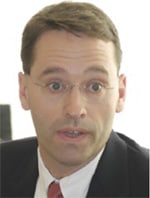
|
|
|
Scott Coffing, managing director, Americas, SunGard Treasury Systems: In terms of banksinteracting with banks, we do things like balance transaction reporting and payments. From a corporate perspective its Tell me whats in my bank account, give me a cash position that I can act upon, maybe Ill do some short-term investing and I make a payment, get some flows through to the bank, the bank gives me a confirmation back in real time with that reference number. Its paid pretty large dividends for a lot of our joint large customers.
Maria Mandler, managing director, global cash management, global transaction services, Citigroup: Corporates want to do things from their workstations and ERP systems directly into our back office. Convergence in terms of formats and protocol is happening for our largest customers, so now smaller corporates can start to see the benefitsand that theres a great opportunity there.
Eric Kamback, executive vice president, The Bank of New York: We all talk about moving toward the Internet and common standards, but, in fact, it will never be perfect because of the variations and diversity of the needs for each corporation. So a big aspect of the future service is how well we can develop the people side of the business.
Jean Francois Hamant, vice president, corporate cash management, SG: That is a true cost for us, which is really substantial, and banks have to take that into account in their pricing program.
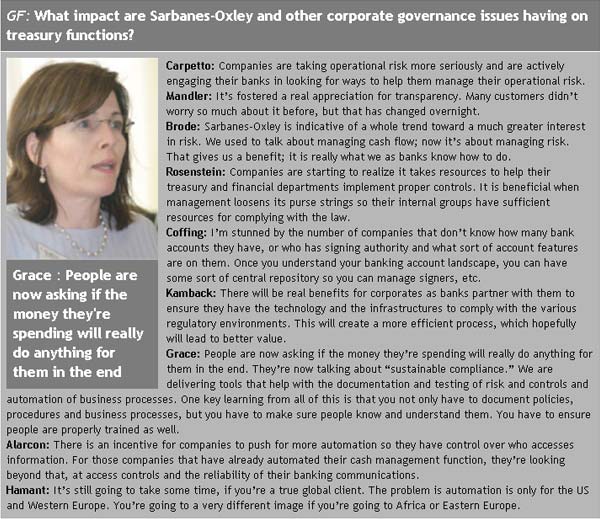
GF:
The importance of checks is diminishing. What impact will this have on corporates and the banks and technologies that are trying to service them?
 |
|
|
Kamback:
The impact overall will be positive because it enhances the available cash and money flows through the corporates. Unfortunately, cash management institutions will have to maintain check processing because checks will be around for a long time.
Carpetto:
Culturally, the United States is much slower to adopt this type of technology, but Check 21 is forcing the issue. Now, banks either have to come on board or its going to start costing them more money.
Mandler:
Youre starting to hear the phrase native electronic payments, where transactions start out electronically as opposed to just ending electronically. Theres an opportunity going forward, especially in the B-to-B space, in terms of fraud protection by having the data go along with the payment.

|
|
|
Coffing
: As the technology gets cleaner, the economics will actually drive things to native electronic processing. People are going to see a big drive to all-electronic payment.
Brode:
Many of our clients are considering leapfrogging the imaging stage and going straight to electronic payments. But we will still need to serve clients at all these different stages and be able to combine the data from those payments and deliver it back to clients.
Rosenstein:
Checks will still exist for a while, and with Check 21 there has been a concern about the potential for an increase in attempts at check fraud. Companies need to ensure theyre using all the tools offered by their banks to prevent check fraud, such as positive pay and payee match services.
Grace:
As it becomes easier from the technology standpoint and from what the banks offer to customers, well see a greater adoption of electronic payment and bill presentment. It allows companies to provide greater service to their customers.
Alarcon:
For some businesses that operate with very low margins, going electronic will be a matter of life or death because thats where it will be determined if they can continue to be competitive within the marketplace or not.
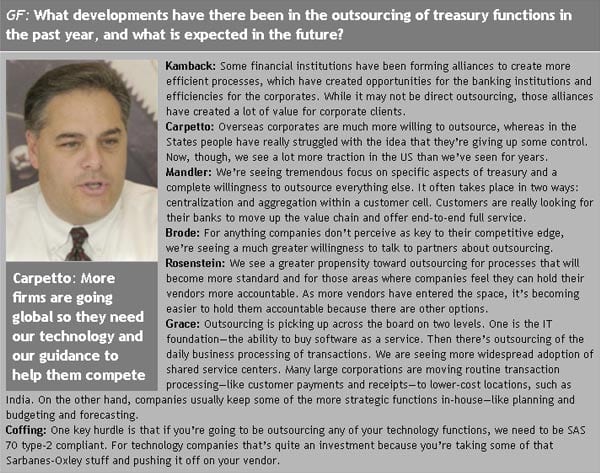
GF:
What developments have there been in working capital management in the past year, and whats expected in the future?
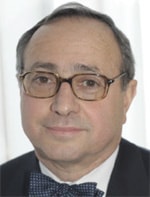 |
|
|
Alarcon:
Treasurers and CFOs are bridging the disconnect between cash management and working capital management [business planning]. Progress is being made in cash flow forecasting from both short-term and long-term planning perspectives. Cash flow forecasting is being taken more seriously.
Mandler:
Theres much more focus on automated execution based on the risk profile. This is where everythings coming togetheraudit trails, risk profile and execution.
Coffing:
CFOs bonuses are being driven by keeping the cash balances to an absolute minimum. To be able to have control over that, you need to be able to run a daily cash cycle. Chief executives are wanting to move from quarterly down to monthly down to weeklyand the end goal is to get dailycash visibility across the entire corporation.

|
|
|
Carpetto:
If we get the efficiencies right and CFOs have access to this information, they can then plan a lot better from a liquidity perspective and make proper investments to manage down to a zero balance. Traditionally, treasury areas are not viewed as a revenue-generation area, but they are starting to demonstrate that they can save millions of dollars in processing.
Rosenstein:
As banks and technology vendors give our customers tools to save them time, they can then get directly involved in the management of inventory, the invoicing and payables process; these things directly impact the working capital.
Brode:
The Homeland Investment Act changes the landscape. If a global client has a lot of money overseas, they can bring it home and use it to invest. The client just found a new, inexpensive source of working capital.
Kamback:
The banks have done a relatively good job in advancing accounting practices and information technology to allow treasurers to better manage their cash, especially on a global basis. There are real efficiencies that have truly helped the treasurers office manage their global cash flow.
Mandler:
Theres also, in North America, an appreciation of new techniques for facilitation of receivable finance.
Grace:
In terms of technology, people are moving toward consolidating their systems. Now you can have one global instance running all over the world, which means a treasurer can not only get the daily bank statement information but also have visibility to any future impacts on cashin any currency for any number of days they want to forecast.
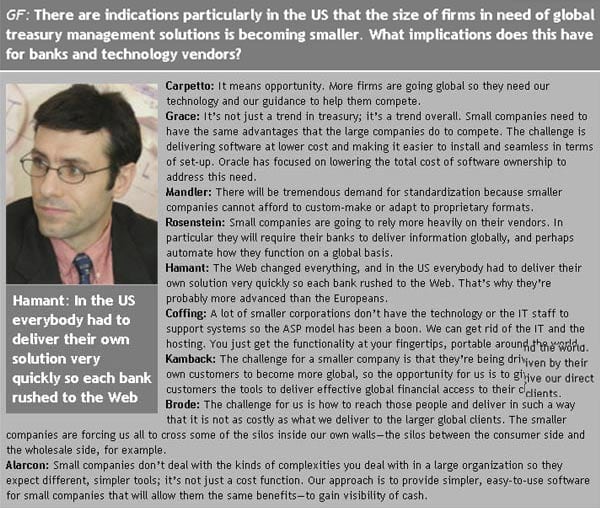
GF:
What are you doing to help your corporate customers perform a better job with global enterprise risk management?
 |
|
talk to partners about outsourcing |
Coffing: First you need to get all your data consolidated. Without consolidated data there is no true risk management. Once youve got all the information in one place and you can very easily present that. The third, more sophisticated step is to assess what is important to each individual corporation and base risk management decisions on that.
Carpetto: Overall, its about education, best practices and roundtables that get corporates to better understand their operating risk. Many of them have ignored certain risks. Its our job to make them aware of those risks and help them to manage them.
Kamback: Most of us have the technology in place that will help all these institutions really mitigate and manage their risk. But we need to educate them about the risks inherent in certain businesses and certain transactions.
Rosenstein: Its extremely important that companies take advantage of the information that banks can provide for them, particularly for cash positioning on a global level. In addition, as companies start to outsource and source important material and production from emerging markets, they need a centralized point within their company to monitor the sovereign risk and better understand their exposure.
Grace: Another area of growing importance is operational riskbeing able to have visibility at every level of the company and across the globe. We can help them monitor the operational risk, as well as consolidate information in one placewhich is one of the keys mentioned earlier.
Moderator: Joseph Giarraputo



